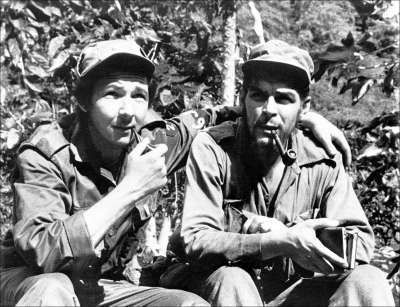Blind over Cuba: 3 of 4: The Photo Gap and the Missile Crisis (Foreign Relations and the Presidency) Hardcover – September 1, 2012. by David M. Barrett (Author), Max Holland (Author)

Photo: Fidel's brother Raúl (left) and Che Guevara (https://en.wikipedia.org/wiki/Che_Guevara) (right) Anonymous - Museo Che Guevara (Centro de Estudios Che Guevara en La Habana, Cuba) Raúl Castro (https://commons.wikimedia.org/wiki/Category:Ra%C3%BAl_Castro) , left, with has his arm around second-in-command, Ernesto “Che” Guevara (https://commons.wikimedia.org/wiki/Category:Che_Guevara) , in Cuba. In their Sierra de Cristal Mountain stronghold south of Havana, in 1958 during the Cuban Revolution (https://commons.wikimedia.org/wiki/Category:Cuban_Revolution) . Permission details This work was created in Cuba (https://commons.wikimedia.org/wiki/Cuba) and is now in the public domain (https://commons.wikimedia.org/wiki/Public_domain) because its term of copyright has expired. According to Cuban law #14 and subsequent amendments (https://commons.wikimedia.org/wiki/Template_talk:PD-Cuba) , copyright terms in Cuba are the following: Type of material Copyright has expired in Cuba if ...Copyright has expired in the US if...¹ Photographs Used more than 25 years ago First published in Cuba without compliance with US copyright formalities and used in Cuba before February 20, 1972 Anonymous works (not photographs) Used more than 50 years ago First published in Cuba without compliance with US copyright formalities and used in Cuba before February 20, 1947 Corporate and government works Never (perpetual copyright) Published before 1925 (95 years ago) All other works More than 50 years has passed since the 1st of January following the death of the author a) Published in Cuba without compliance with US copyright formalities, author died before 1947 or b) Published before 1925 (95 years ago) For a file to be hosted on Wikimedia Commons, it must be in the public domain in both Cuba and the United States. ¹For a work to be public domain in the United States, its copyright must have expired in Cuba before Cuba joined the Berne Convention on February 20, 1997. Note 2: Notwithstanding the conditions set above, the state of Cuba may decide to transfer to the state the copyright on works when the copyright term for the creator of it has expired, as set by the 48º article of Cuban Copyright law. Such works would not be free of copyright, and may be deleted at any time.View more (https://en.wikipedia.org/wiki/Fidel_Castro#) Public Domain (https://commons.wikimedia.org/wiki/File:Raulche2.jpg) view terms File:Raulche2.jpg Created: 1 January 1958 http://JohnBatchelorShow.com/contact http://JohnBatchelorShow.com/schedules Twitter: @BatchelorShow Blind over Cuba: 3 of 4: The Photo Gap and the Missile Crisis (Foreign Relations and the Presidency) Hardcover – September 1, 2012. by David M. Barrett (https://www.amazon.com/David-M-Barrett/e/B000APW288/ref=dp_byline_cont_book_1) (Author), Max Holland (https://www.amazon.com/Max-Holland/e/B001H6MB44/ref=dp_byline_cont_book_2) (Author) https://www.amazon.com/Blind-over-Cuba-Relations-Presidency/dp/1603447687/ref=tmm_hrd_swatch_0?_encoding=UTF8&qid=&sr= In the aftermath of the Cuban Missile Crisis, questions persisted about how the potential cataclysm had been allowed to develop. A subsequent congressional investigation focused on what came to be known as the “photo gap”: five weeks during which intelligence-gathering flights over Cuba had been attenuated. In Blind over Cuba, David M. Barrett and Max Holland challenge the popular perception of the Kennedy administration’s handling of the Soviet Union’s surreptitious deployment of missiles in the Western Hemisphere. Rather than epitomizing it as a masterpiece of crisis management by policy makers and the administration, Barrett and Holland make the case that the affair was, in fact, a close call stemming directly from decisions made in a climate of deep distrust between key administration officials and the intelligence community. Because of White House and State Department fears of “another U-2 incident” (the infamous 1960 Soviet downing of an American U-2 spy plane), the CIA was not permitted to send surveillance aircraft on prolonged flights over Cuban airspace for many weeks, from late August through early October. Events proved that this was precisely the time when the Soviets were secretly deploying missiles in Cuba. When Director of Central Intelligence John McCone forcefully pointed out that this decision had led to a dangerous void in intelligence collection, the president authorized one U-2 flight directly over western Cuba—thereby averting disaster, as the surveillance detected the Soviet missiles shortly before they became operational. The Kennedy administration recognized that their failure to gather intelligence was politically explosive, and their subsequent efforts to influence the perception of events form the focus for this study. Using recently declassified documents, secondary materials, and interviews with several key participants, Barrett and Holland weave a story of intra-agency conflict, suspicion, and discord that undermined intelligence-gathering, adversely affected internal postmortems conducted after the crisis peaked, and resulted in keeping Congress and the public in the dark about what really happened. Fifty years after the crisis that brought the superpowers to the brink, Blind over Cuba: The Photo Gap and the Missile Crisis offers a new chapter in our understanding of that pivotal event, the tensions inside the US government during the cold war, and the obstacles Congress faces when conducting an investigation of the executive branch.